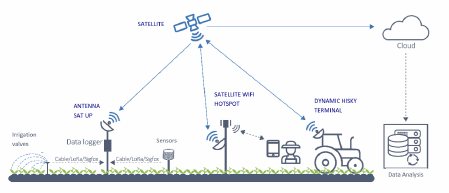Hispasat, the Spanish communications satellite operator from the Red Eléctrica Group, and Eurona, the Spanish multinational telecommunications firm, are implementing two pilot projects to promote digital transformation in the rural agrofood sector and to bridge the digital divide in the field through technologies like satellites and WiFi hotspots. The initiatives are being carried out in the provinces of Ávila and Alicante in collaboration with local farmers and ranchers.
The first is being developed by Digitanimal, which manufactures systems to locate and monitor livestock. This project involves improving satellite connectivity for a 400-hectare farm located on a mountain in Ávila through an antenna aimed at the Hispasat fleet. This antenna can send the data received from the sensors placed on 130 cattle to the control centre.
The other pilot programme is located in a crop field in Florette, the packaged salads and vegetables company, where a satellite WiFi hotspot has been installed. This technology provides broadband connectivity so that the farmhands can manage the crops in real time from their mobile devices, without having to move to more remote areas with land-based connectivity.
Both projects have been presented as part of the DATAGRI framework, the biggest digital transformation event in the Spanish agrofood sector, which is held this week in Zaragoza. Satellite technology provides connectivity in areas in which land-based telecommunications are insufficient and allow actors in the rural area to join in on the digital transformation process. Spain still lacks broadband coverage in rural areas and there are more than 2,040 towns which do not have Internet access1 .
Using these innovations benefits both the companies that conduct the intelligent management of agricultural farms, allowing them to expand their market share and reach territories that lack landbased communications, as well as the farm owners themselves, allowing them to take better decisions, increase their productivity, and reduce the consumption of water, fertiliser, and plant 1 Number of towns without Internet access at a minimum rate of 10 MB per second, according to data from the 2018 Broadband Coverage Report in Spain. Ministry of Energy, Tourism, and Digital Agenda. health products. This technology ensures that products are traceable and helps to minimise the impact of the agricultural-livestock activity on the environment.
How Satellite Technology Works
 Hispasat's satellite technology allows the company to provide an immediate, reliable internet connection at any location in Spain, which makes it the ideal technological solution for the agrofood sector. Eurona's hotspot technology is a perfect complement in that it can equip agricultural farms with satellite WiFi hotspots to make it easier for farmers to communicate, run their farms, and send the photos and information received from the field in real time. Likewise, a small-size, energy-efficient, and easy-to-install satellite terminal is capable of transmitting continuous data sent from the sensors that monitor the livestock or crops. Lastly, self-orienting satellite terminals are an optimal solution for connectivity in mobility environments like agricultural machinery. All these can work with a solar energy plate. Agriculture 4.0, a fundamental step to respond to the growing world population In Spain, around 3.2 million people still cannot access a quality Internet network, especially in rural, sparsely populated, and difficult-to-reach areas.
Hispasat's satellite technology allows the company to provide an immediate, reliable internet connection at any location in Spain, which makes it the ideal technological solution for the agrofood sector. Eurona's hotspot technology is a perfect complement in that it can equip agricultural farms with satellite WiFi hotspots to make it easier for farmers to communicate, run their farms, and send the photos and information received from the field in real time. Likewise, a small-size, energy-efficient, and easy-to-install satellite terminal is capable of transmitting continuous data sent from the sensors that monitor the livestock or crops. Lastly, self-orienting satellite terminals are an optimal solution for connectivity in mobility environments like agricultural machinery. All these can work with a solar energy plate. Agriculture 4.0, a fundamental step to respond to the growing world population In Spain, around 3.2 million people still cannot access a quality Internet network, especially in rural, sparsely populated, and difficult-to-reach areas.
Considering these data and in line with the UN's forecasts, which predict that by 2050 the world population will grow by more than 33%, reaching 9.1 billion people, Eurona and Hispasat are seeking to respond to the challenges posed by this growth, by increasing the productivity and sustainability of the agricultural sector. According to the forecasts from the FAO's '2019 Global Perspectives Studies', this sector must be 70%-80% digitised in the next 5 years to be able to satisfy the increased demand for food.
To make this objective possible, the two companies are working together to set up IoT (Internet of Things) solutions aimed at meeting the specific demands of the agrofood sector, paving the way for the arrival of 'Agriculture 4.0'. This new agriculture requires processes that are digitised, automated, and more flexible to promote competition in the sector thanks to a more suitable use of resources: intelligent fertiliser use, reduction of water consumption, crop monitoring, disease and pest control, etc.





